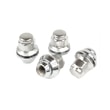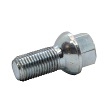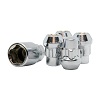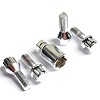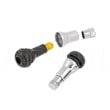Braking distance. Find out how to calculate it and what influences it.
Braking distance is one of the most important factors affecting road safety. Understanding how to calculate it and the factors that influence it can help you avoid accidents and increase driving safety. In this article, we'll discuss under what conditions braking distance is longest, how ABS affects stopping distance, and how various factors, such as speed, weather conditions, and vehicle condition, affect braking distance.
What exactly is braking distance and why is it so important for road safety?
Braking distance is the distance a vehicle travels from the moment it begins to brake until it comes to a complete stop. This is a key parameter affecting road safety, as it determines whether the driver will be able to stop the vehicle in time before an obstacle or another road user.
Knowing a car's braking distance allows drivers to better plan maneuvers and maintain an appropriate distance from other vehicles. This can help avoid dangerous situations, such as sudden braking that can lead to a collision.
It's also important to understand what determines braking distance. Many factors influence braking distance, including vehicle speed, road conditions, weather conditions, and the vehicle's technical condition. Therefore, it's crucial to regularly check your car's condition and adapt your driving style to the prevailing conditions.
How to calculate braking distance? Use the formula.
To accurately calculate braking distance, you can use a mathematical formula. The formula for braking distance is:
Braking distance = v2 2⋅f⋅g
Where:
- v – vehicle speed in meters per second (m/s),
- f – coefficient of friction between tires and road surface,
- g – acceleration of gravity (9.81 m/s²).
For example: the braking distance of a car at 50 km/h (i.e. 13.89 m/s) on dry asphalt, where the coefficient of friction is approximately 0.8, will be:
Braking distance = (13.89)2 2⋅0.8⋅9.81 ≈ 12.3 meters
Calculating braking distance using this formula allows drivers to better understand how speed and other factors affect the distance it takes to stop a vehicle.
Is there a difference between stopping distance and braking distance?
Although the terms braking distance and stopping distance are often used interchangeably, they are different. Stopping distance includes both the driver's reaction time and the braking distance itself. This means that stopping distance is always longer than the braking distance itself.
Driver reaction time is the time it takes from the moment a driver notices an obstacle to the moment they initiate braking. It typically takes about 1 second, but can vary depending on many factors, such as fatigue, health, and road conditions.
For example, at a speed of 50 km/h, a vehicle moves approximately 14 meters in 1 second. This means that the stopping distance at this speed is the sum of the distance traveled by the driver's reaction time and the car's braking distance, which is approximately 26.3 meters.
Why does it take longer to brake the faster you go? Braking distance and speed
Braking distance increases with the square of the speed, meaning that doubling speed quadruples braking distance. For example, if your braking distance is 12.3 meters at 50 km/h, it will be approximately 49.2 meters at 100 km/h.
This phenomenon is a result of the physical principles of motion and the action of braking forces. Higher speeds mean more kinetic energy that the brakes must dissipate to stop the vehicle. Therefore, at higher speeds, it is necessary to brake earlier.
Knowing the relationship between speed and braking distance allows drivers to better adapt their driving behavior. It's important to remember this rule, especially on highways and expressways, where speeds are higher.
How do rain, snow and ice affect braking distance?
Weather conditions have a huge impact on a car's braking distance. On wet roads, the coefficient of friction between the tires and the road is lower, which increases stopping distances. Braking distances on wet surfaces can be up to twice as long as on dry surfaces.
Snow and ice complicate matters even further. The coefficient of friction on icy roads is very low, resulting in braking distances that can be up to four times longer than on dry surfaces. In such conditions, extreme caution and significant speed reduction are necessary.
To increase driving safety in difficult weather conditions, it is worth investing in appropriate tires and checking their condition regularly.
How to calculate a safe distance between vehicles?
Calculating a safe distance between vehicles is crucial to avoiding a collision. This safe distance should be large enough to give the driver enough time to react and stop the vehicle in the event of sudden braking by the car in front.
The simplest method is the two-second rule, which involves maintaining a distance from the vehicle in front that you cover in two seconds. At a speed of 50 km/h, this is approximately 28 meters, and at 100 km/h, approximately 56 meters.
In difficult weather conditions, such as rain, snow, or ice, this distance should be even greater. This gives the driver more time to react and safely stop the vehicle. Regularly checking the vehicle's technical condition, including TPMS sensors, tires, and the condition of alloy wheels , also contributes to increased road safety.
Does ABS shorten braking distance?
Anti-lock Braking System (ABS) is designed to prevent the wheels from locking during braking, allowing the driver to maintain control of the vehicle. But does ABS shorten stopping distances? The answer is ambiguous, as ABS doesn't always shorten stopping distances, but it does provide greater vehicle control during braking.
Under normal driving conditions, ABS can slightly increase stopping distances because the system pulses to release and reapply the brakes, preventing wheel lockup. However, on slippery surfaces, such as wet, snowy, or icy roads, ABS can significantly improve vehicle stability and handling, which is crucial for safety.
The greatest advantage of ABS is its ability to maneuver while braking. This allows the driver to avoid obstacles or turn, something that would be impossible if the wheels were locked. Therefore, although ABS may extend braking distances in some situations, its safety benefits are invaluable.
How does driver reaction time affect braking distance?
A driver's reaction time is the time it takes from the moment they notice an obstacle to the moment they initiate braking. Typically, this takes about 1 second. Reaction time directly affects stopping distance, which includes both the distance traveled while reacting and the braking distance. For example, at a speed of 50 km/h, the vehicle moves approximately 14 meters in 1 second. Therefore, if the reaction time is 1 second, 14 meters must be added to the braking distance to obtain the full stopping distance.
To improve reaction times and safety, drivers should stay focused, avoid distractions, and rest regularly on long journeys. It's also important to maintain an appropriate distance from other vehicles, allowing for safe stopping in the event of an emergency.

Braking distance of a motorcycle and a car – key differences
The braking distance of a motorcycle and a car is not the same due to differences in weight, braking systems, and tire contact patch. Motorcycles are typically lighter than cars, which might suggest shorter braking distances, but in practice, the situation is more complicated.
Motorcycles have a smaller tire-to-road contact patch, which impacts braking performance. Furthermore, a motorcycle's braking stability is significantly lower than that of a car, increasing the risk of skidding and extending braking distances.
Additionally, braking techniques on a motorcycle differ from those used in a car. Riders must skillfully balance braking power between the front and rear wheels to avoid loss of stability. Therefore, a motorcycle's stopping distance can be longer than that of a car, despite the vehicle's lower weight.
The influence of the car's technical condition on the braking distance
A car's technical condition has a crucial impact on its stopping distance. Regular inspections and maintenance of brakes, tires, and other braking system components are essential to ensure their proper operation and shorten stopping distances.
Worn or improperly inflated tires can significantly increase braking distances on wet surfaces and in challenging weather conditions. Therefore, it's important to regularly check your tires and use TPMS sensors to monitor tire pressure.
The condition of your brakes is also crucial. Worn brake pads, discs, or brake fluid can lead to longer stopping distances and an increased risk of accidents. Regular maintenance and proper braking system maintenance are crucial to ensuring road safety.
Braking distance is a key parameter affecting driving safety. Understanding how to calculate braking distance, the factors that influence it, and how to maintain your vehicle's technical condition can significantly improve road safety. Regular inspections, appropriate tires and steel or aluminum rims , and maintaining a proper distance from other vehicles are the basics every driver should follow to ensure a safe journey for themselves and other road users.




 Modern design
Modern design Perfect fit
Perfect fit High durability
High durability Free shipping within 24 hours
Free shipping within 24 hours
 Individual project
Individual project Dedicated caregiver
Dedicated caregiver
